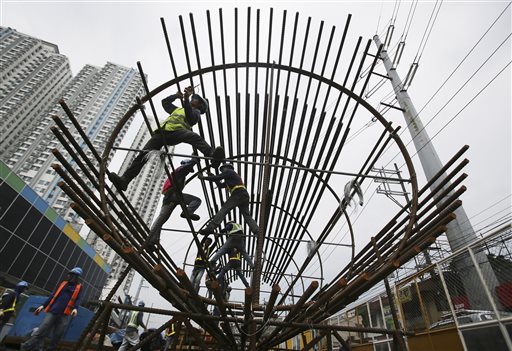Asean think tank cuts 2017, 2018 growth forecasts for PH

In this Aug. 12, 2015, photo, Filipino workers arrange metal rods at a government road project in Quezon City. AP PHOTO
Think tank Asean+3 Macroeconomic Research Office (Amro) has cut its 2017 and 2018 growth forecasts for the Philippines partly on the back of slower investment and consumption in the first half, while flagging risks if the government cannot deliver on its ambitious infrastructure plan.
“The Philippine economy is expected to grow by 6.6 percent this year before quickening to 6.8 percent in 2018 as public sector infrastructure spending gains pace while domestic consumption and exports remain buoyant. To support the infrastructure program and enhance growth potential, mobilizing sufficient revenue via tax reforms is essential,” Amro lead economist Sumio Ishikawa said in a statement Tuesday.
In May, Amro’s projection was 6.8-percent gross domestic product (GDP) expansion this year and 7-percent growth for next year.
Amro’s updated forecast for 2017 was still within the government’s 6.5-7.5 percent target, but the new 2018 projection was below the 7-8 percent target range for next year.
“After the boost from elections‑related spending in 2016, the pace of economic expansion moderated to 6.4 percent in the first half of 2017 as fixed investment decelerated. Private consumption growth also slowed but nonetheless remained robust, supported by gains in employment and sustained remittance inflows,” Amro noted.
Article continues after this advertisement“Government disbursement was weak in the first quarter, but improved in the second quarter to guide public spending higher. The trade deficit eased in the first half of 2017 as exports outpaced imports for the first time since the first quarter of 2015. Both private consumption and exports are expected to remain buoyant going forward, while hurdles to budget execution are also gradually being overcome,” Amro added.
Article continues after this advertisementThe think tank said the Philippine economy “continues to have sound macro fundamentals, which should make it less vulnerable to shocks” even as it warned that delays in the Duterte administration’s “Build, Build, Build” infrastructure program pose risks.
“Failure to accelerate infrastructure investments through the ‘Build, Build, Build’ program owing to, among others, absorptive capacity constraints of the government and private sector participants could dampen investment activity and undermine growth prospects. A delay in infrastructure projects execution also risks having the additional revenues from the comprehensive tax reform program being diverted to other expenditure items with little growth potential,” Amro said.
“On the other hand, as the infrastructure program gains traction, it may lead to a widening of the current account deficit in the medium term, which could in turn put strong depreciation pressures on the peso. Likewise, brisk fiscal spending adding to an already buoyant domestic demand, rapid credit growth, and rising inflation could give rise to overheating pressures in the near term, although this risk may diminish over the medium term as the economy’s productive capacity improves,” it added.
“Overall, the ‘Build, Build, Build’ program should be implemented with a view to boosting growth while keeping the current account and fiscal deficits at moderate levels,” as well as “complemented with the timely implementation of the comprehensive tax reform program in order to mobilize the revenue for greater infrastructure spending,” according to Amro.
The Duterte administration early this year unveiled the “Build, Build, Build” program aimed at ushering in “the golden age of infrastructure” after years of neglect.
Under “Build, Build, Build,” the government would rollout 75 flagship, “game-changing” infrastructure projects, with about half targeted to be finished within President Duterte’s term, alongside plans to spend a total of up to P9 trillion on hard and modern infrastructure until 2022.
Following last month’s annual consultation visit of Amro economists to the Philippines last month, the think tank called on the government to introduce “reforms to improve the country’s business climate and stimulate investments across sectors,” citing that doing so would “crowd-in private investments and create more employment opportunities for the country’s young, large, and growing labor force, in turn raising the economy’s productive capacity.”
Also, “capacity for disaster preparedness and resilience would also have to be further strengthened given the country’s high exposure to natural disasters,” Amro said.
Last week, the World Bank also slashed its growth projections for the Philippines for both 2017 and 2018 due to “slower than expected” implementation of public infrastructure projects so far. /cbb